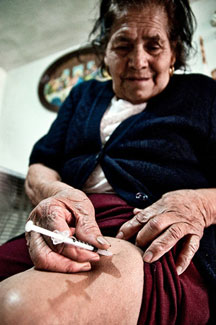A group of chemicals found in household plastics and medical supplies is linked to higher rates of diabetes in women – up to double the rate for women with the highest levels, according to new research led by Harvard scientists. Blacks and Mexican Americans and women living in poverty are exposed to the highest levels of some of these compounds, called phthalates. “It’s extremely likely that phthalates and other chemical contaminants will turn out to be a big part of the obesity and diabetes epidemic, but at this point we really don't know how these chemicals are interacting with each other, or with the human body,” said Richard Stahlhut, a University of Rochester scientist who co-authored the study.
By Crystal Gammon
Environmental Health News
July 30, 2012
A group of chemicals found in household plastics and medical supplies is linked to higher rates of diabetes in women – up to double the rate for women with the highest levels, according to new research led by Harvard scientists.
Blacks and Mexican Americans and women living in poverty are exposed to the highest levels of some of these compounds, called phthalates, the scientists reported.
Whether these chemicals actually cause diabetes in women, however, remains unclear.
“These findings are important clues, but it’s only a first step,” said Richard Stahlhut, an environmental health researcher at the University of Rochester Medical Center who co-authored the study. “It’s extremely likely that phthalates and other chemical contaminants will turn out to be a big part of the obesity and diabetes epidemic, but at this point we really don't know how these chemicals are interacting with each other, or with the human body.”
Phthalates make plastics such as polyvinyl chloride (PVC) more flexible, and they are added to some cosmetics, perfumes and other personal care products to stabilize colors and fragrances. A wide variety of household goods rely on phthalates, including vinyl flooring, adhesives and shower curtains. More than 75 percent of Americans have phthalates in their urine.
By Crystal Gammon
Environmental Health News
July 30, 2012
A group of chemicals found in household plastics and medical supplies is linked to higher rates of diabetes in women – up to double the rate for women with the highest levels, according to new research led by Harvard scientists.
Blacks and Mexican Americans and women living in poverty are exposed to the highest levels of some of these compounds, called phthalates, the scientists reported.
Whether these chemicals actually cause diabetes in women, however, remains unclear.
“These findings are important clues, but it’s only a first step,” said Richard Stahlhut, an environmental health researcher at the University of Rochester Medical Center who co-authored the study. “It’s extremely likely that phthalates and other chemical contaminants will turn out to be a big part of the obesity and diabetes epidemic, but at this point we really don't know how these chemicals are interacting with each other, or with the human body.”
Phthalates make plastics such as polyvinyl chloride (PVC) more flexible, and they are added to some cosmetics, perfumes and other personal care products to stabilize colors and fragrances. A wide variety of household goods rely on phthalates, including vinyl flooring, adhesives and shower curtains. More than 75 percent of Americans have phthalates in their urine.
Blacks have a 77 percent higher rate and Hispanics have a 66 percent higher rate of developing diabetes than whites.

 RSS Feed
RSS Feed
